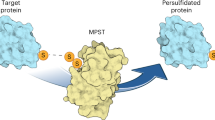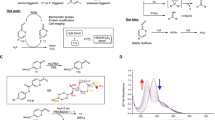Abstract
Nitric oxide (NO) signaling through the formation of cGMP is well established; however, there seems to be an increasing role for cGMP-independent NO signaling. Although key molecular details remain unanswered, S-nitrosation represents an example of cGMP-independent NO signaling. This modification has garnered recent attention as it has been shown to modulate the function of several important biochemical pathways1,2,3. Although an analogy to O-phosphorylation can be drawn4, little is known about protein nitrosothiol regulation in vivo. In solution, NO readily reacts with oxygen to yield a nitrosating agent, but this process alone provides no specificity for nitrosation5. This lack of specificity is exemplified by the in vitro poly-S-nitrosation of caspase-3 (Casp-3, ref. 6) and the ryanodine receptor7. Previous in vivo work with Casp-3 suggests that a protein-assisted process may be responsible for selective S-nitrosation of the catalytic cysteine (Cys163)8. We demonstrated that a single cysteine in thioredoxin (Trx) is capable of a targeted, reversible transnitrosation reaction with Cys163 of Casp-3. A greater understanding of how S-nitrosation is mediated has broad implications for cGMP-independent signaling. The example described here also suggests a new role for Trx in the regulation of apoptosis.
This is a preview of subscription content, access via your institution
Access options
Subscribe to this journal
Receive 12 print issues and online access
$259.00 per year
only $21.58 per issue
Buy this article
- Purchase on Springer Link
- Instant access to full article PDF
Prices may be subject to local taxes which are calculated during checkout


Similar content being viewed by others
References
Foster, M.W., McMahon, T.J. & Stamler, J.S. S-nitrosylation in health and disease. Trends Mol. Med. 9, 160–168 (2003).
Hess, D.T., Matsumoto, A., Kim, S.O., Marshall, H.E. & Stamler, J.S. Protein S-nitrosylation: purview and parameters. Nat. Rev. Mol. Cell Biol. 6, 150–166 (2005).
Hess, D.T., Matsumoto, A., Nudelman, R. & Stamler, J.S. S-nitrosylation: spectrum and specificity. Nat. Cell Biol. 3, E46–E49 (2001).
Lane, P., Hao, G. & Gross, S.S. S-nitrosylation is emerging as a specific and fundamental posttranslational protein modification: head-to-head comparison with O-phosphorylation. Sci. STKE 2001, RE1 (2001).
Keshive, M., Singh, S., Wishnok, J.S., Tannenbaum, S.R. & Deen, W.M. Kinetics of S-nitrosation of thiols in nitric oxide solutions. Chem. Res. Toxicol. 9, 988–993 (1996).
Zech, B., Wilm, M., van Eldik, R. & Brune, B. Mass spectrometric analysis of nitric oxide-modified caspase-3. J. Biol. Chem. 274, 20931–20936 (1999).
Xu, L., Eu, J.P., Meissner, G. & Stamler, J.S. Activation of the cardiac calcium release channel (ryanodine receptor) by poly-S-nitrosylation. Science 279, 234–237 (1998).
Mannick, J.B. et al. Fas-induced caspase denitrosylation. Science 284, 651–654 (1999).
Nicholson, D.W. et al. Identification and inhibition of the ICE/CED-3 protease necessary for mammalian apoptosis. Nature 376, 37–43 (1995).
Thornberry, N.A. & Lazebnik, Y. Caspases: enemies within. Science 281, 1312–1316 (1998).
Mannick, J.B., Asano, K., Izumi, K., Kieff, E. & Stamler, J.S. Nitric oxide produced by human B lymphocytes inhibits apoptosis and Epstein-Barr virus reactivation. Cell 79, 1137–1146 (1994).
Brune, B., von Knethen, A. & Sandau, K.B. Nitric oxide and its role in apoptosis. Eur. J. Pharmacol. 351, 261–272 (1998).
Mohr, S., Zech, B., Lapetina, E.G. & Brune, B. Inhibition of caspase-3 by S-nitrosation and oxidation caused by nitric oxide. Biochem. Biophys. Res. Commun. 238, 387–391 (1997).
Zech, B., Kohl, R., von Knethen, A. & Brune, B. Nitric oxide donors inhibit formation of the Apaf-1/caspase-9 apoptosome and activation of caspases. Biochem. J. 371, 1055–1064 (2003).
Maejima, Y., Adachi, S., Morikawa, K., Ito, H. & Isobe, M. Nitric oxide inhibits myocardial apoptosis by preventing caspase-3 activity via S-nitrosylation. J. Mol. Cell. Cardiol. 38, 163–174 (2005).
Kim, J.E. & Tannenbaum, S.R. S-Nitrosation regulates the activation of endogenous procaspase-9 in HT-29 human colon carcinoma cells. J. Biol. Chem. 279, 9758–9764 (2004).
Powis, G. & Montfort, W.R. Properties and biological activities of thioredoxins. Annu. Rev. Pharmacol. Toxicol. 41, 261–295 (2001).
Haendeler, J. et al. Redox regulatory and anti-apoptotic functions of thioredoxin depend on S-nitrosylation at cysteine 69. Nat. Cell Biol. 4, 743–749 (2002).
Tao, L. et al. Cardioprotective effects of thioredoxin in myocardial ischemia and reperfusion: role of S-nitrosation [corrected]. Proc. Natl. Acad. Sci. USA 101, 11471–11476 (2004).
Jaffrey, S.R. & Snyder, S.H. The biotin switch method for the detection of S-nitrosylated proteins. Sci. STKE 2001, PL1 (2001).
Rotonda, J. et al. The three-dimensional structure of apopain/CPP32, a key mediator of apoptosis. Nat. Struct. Biol. 3, 619–625 (1996).
Cook, J.A. et al. Convenient colorimetric and fluorometric assays for S-nitrosothiols. Anal. Biochem. 238, 150–158 (1996).
Nikitovic, D. & Holmgren, A. S-nitrosoglutathione is cleaved by the thioredoxin system with liberation of glutathione and redox regulating nitric oxide. J. Biol. Chem. 271, 19180–19185 (1996).
Sliskovic, I., Raturi, A. & Mutus, B. Characterization of the S-denitrosation activity of protein disulfide isomerase. J. Biol. Chem. 280, 8733–8741 (2005).
Qin, J., Clore, G.M. & Gronenborn, A.M. The high-resolution three-dimensional solution structures of the oxidized and reduced states of human thioredoxin. Structure 2, 503–522 (1994).
Mitchell, D.A., Erwin, P.A., Michel, T. & Marletta, M.A. S-Nitrosation and regulation of inducible nitric oxide synthase. Biochemistry 44, 4636–4647 (2005).
Holmgren, A. Thioredoxin catalyzes the reduction of insulin disulfides by dithiothreitol and dihydrolipoamide. J. Biol. Chem. 254, 9627–9632 (1979).
Ren, X., Bjornstedt, M., Shen, B., Ericson, M.L. & Holmgren, A. Mutagenesis of structural half-cystine residues in human thioredoxin and effects on the regulation of activity by selenodiglutathione. Biochemistry 32, 9701–9708 (1993).
Rossi, R. et al. A method to study kinetics of transnitrosation with nitrosoglutathione: reactions with hemoglobin and other thiols. Anal. Biochem. 254, 215–220 (1997).
Wang, K. et al. Equilibrium and kinetics studies of transnitrosation between S-nitrosothiols and thiols. Bioorg. Med. Chem. Lett. 11, 433–436 (2001).
Thornberry, N.A. et al. A combinatorial approach defines specificities of members of the caspase family and granzyme B. Functional relationships established for key mediators of apoptosis. J. Biol. Chem. 272, 17907–17911 (1997).
Gow, A.J., Buerk, D.G. & Ischiropoulos, H. A novel reaction mechanism for the formation of S-nitrosothiol in vivo. J. Biol. Chem. 272, 2841–2845 (1997).
Zhang, J., Li, Y.D., Patel, J.M. & Block, E.R. Thioredoxin overexpression prevents NO-induced reduction of NO synthase activity in lung endothelial cells. Am. J. Physiol. 275, L288–L293 (1998).
Acknowledgements
We wish to thank A. Falick (University of California, Berkeley) for acquiring the CID spectra. We also thank members of the Marletta laboratory for helpful discussions and critical review of the manuscript. This work is supported in part by grants from the DeBenedictis Fund of University of California, Berkeley to M.A.M. and US National Institutes of Health grant CA 26731.
Author information
Authors and Affiliations
Corresponding author
Ethics declarations
Competing interests
The authors declare no competing financial interests.
Supplementary information
Supplementary Fig. 1
Purification of caspase-3, wild-type thioredoxin and C73S thioredoxin. (PDF 1070 kb)
Supplementary Fig. 2
S-Nitrosation and S-glutathiolation of the catalytic nucleophile (C163) of caspase-3 by excess GSNO. (PDF 96 kb)
Supplementary Fig. 3
Poly-S-nitrosation of caspase-3. (PDF 94 kb)
Supplementary Fig. 4
S-Nitrosation of C73 of thioredoxin by excess GSNO. (PDF 55 kb)
Supplementary Fig. 5
Collision-induced dissociation spectra. (PDF 394 kb)
Supplementary Fig. 6
Caspase-3-C163-SNO S-nitrosates C73 of His-Trx. (PDF 118 kb)
Rights and permissions
About this article
Cite this article
Mitchell, D., Marletta, M. Thioredoxin catalyzes the S-nitrosation of the caspase-3 active site cysteine. Nat Chem Biol 1, 154–158 (2005). https://doi.org/10.1038/nchembio720
Received:
Accepted:
Published:
Issue Date:
DOI: https://doi.org/10.1038/nchembio720
This article is cited by
-
TRAP1 S-nitrosylation as a model of population-shift mechanism to study the effects of nitric oxide on redox-sensitive oncoproteins
Cell Death & Disease (2023)
-
Comparative transcriptomic analysis reveals gene regulation mediated by caspase activity in a chordate organism
BMC Molecular and Cell Biology (2021)
-
Proteogenomic landscape of uterine leiomyomas from hereditary leiomyomatosis and renal cell cancer patients
Scientific Reports (2021)
-
1H, 15N and 13C backbone and side‐chain assignments of reduced and S-nitrosated C62only mutant of human thioredoxin
Biomolecular NMR Assignments (2021)
-
TCA cycle metabolic compromise due to an aberrant S-nitrosoproteome in HIV-associated neurocognitive disorder with methamphetamine use
Journal of NeuroVirology (2021)



